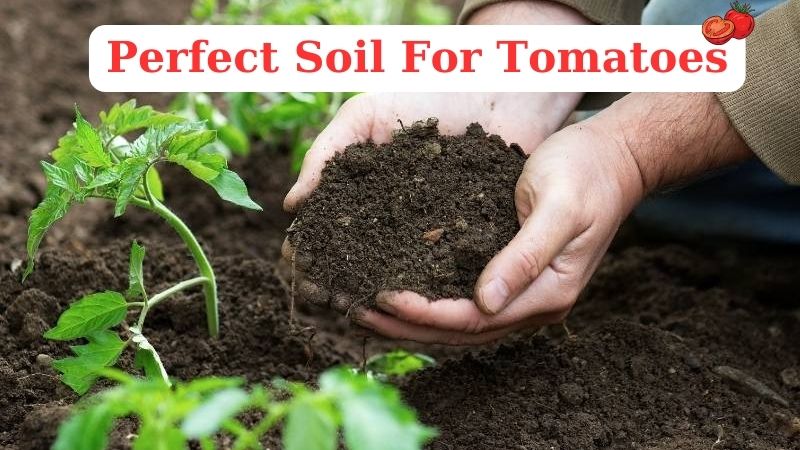The best harvest starts with preparing the perfect soil for tomatoes plants. Though unglamorous and often overlooked, the soil around tomato roots determines the quality and quantity of the harvest. The best tomatoes, rich in flavor and vibrant color, grow from organically rich soil, filled with nutrients essential for plant growth, along with a host of beneficial soil bacteria that contribute contributes to everything from drainage to disease resistance. Join Garden Creatives to learn how to create the perfect soil for tomatoes.
Tips for Creating perfect soil for tomatoes
1. Add Compost to Create Perfect Soil for Tomatoes
Nutrient-filled organic compost is the best way to improve any type of garden soil, from heavy clay to fast-draining sandy soil. Compost provides the elements tomato plants need to grow healthy foliage and produce delicious-tasting fruit. It helps improve soil structure, replenish air space and enhance the soil’s ability to retain moisture. Compost also maintains many beneficial organisms such as fungi, beneficial bacteria, and vibrant earthworm populations. In short, compost is the optimal soil improvement method for tomato growth.
2. Soil Testing
Perform a soil test to better understand your local soil characteristics. You can have your soil tested through your state extension service or online commercial soil testing laboratories. A soil test will analyze the nutrient content and pH of the soil. Based on the results, you will receive a specific soil amendment formula, helping you know exactly what to add and how much is needed to create the perfect soil for tomato plants.
3. Plant Crop Rotation
Tomato diseases, such as early blight, can survive in the soil and infect annual crops. To minimize the spread of the disease, plant tomatoes in a new location each year following a three-year crop rotation plan. Crop rotation is an effective method for controlling soil-borne diseases, helping your tomato plants grow healthy and reducing the risk of disease.
4. Stay away from contaminated areas
Some soil types are not suitable for growing tomatoes. For example, soil near black walnut trees is not an ideal choice. Black walnut trees secrete a chemical called juglone, which is toxic to many plants, including tomatoes. Juglone penetrates the soil beneath the tree canopy and spreads far from the base of the tree. So, don’t plant tomatoes near walnut trees. Find another location or plant in a container to ensure plant safety.
5. Use Organic Mulch
Mulching around tomato plants helps suppress weeds and retain soil moisture. Using organic mulch, such as compost, shredded bark or grass clippings that do not contain grass seeds, will improve soil structure. Organic mulch slowly decomposes and blends into the top layer of the soil, adding nutrients and improving structure.
A layer of mulch about 2 inches thick is ideal for the soil around each tomato plant. Wait until the soil is warm enough in spring before applying mulch; Mulch will help insulate the soil during hot summer days, but warm soil is needed to promote growth in early spring.
6. Consider Raising Your Planting Bed
Raised beds are a great way to create the perfect soil for tomatoes. If your planting area is affected by contaminated soil, boggy clay or overly sandy soil, build raised beds and fill them with high-quality topsoil. You can purchase raised beds that are easy to assemble for added convenience. Raised beds not only help you better control soil quality but also help tomato plants grow stronger and achieve higher yields.
7. Cover Plants Are a Good Idea
Cover crops, also known as green manure, are planted in early spring or fall, improving the structure and fertility of garden soil. Tomato cover crops are grown until flowering begins, then they are cut back and buried in the soil to decompose naturally, providing nutrients to the soil. Good cover crops for tomatoes include winter rye, annual ryegrass, and winter wheat.
8. Skip Fertilizers That Contain Herbicides
When fertilizing tomatoes, read product labels carefully to avoid using fertilizers containing herbicides. These products are popular but are not suitable for tomato plants. The herbicide in the product can leach into the soil, harming or killing young tomato plants. So, choose herbicide-free fertilizers to protect your plants.
9. Don’t Neglect Cleaning
At the end of the tomato growing season, diseased plant parts should be removed. Bury or burn diseased stems and leaves; Don’t add them to the compost pile to avoid spreading diseases. After removing diseased plants, mow remaining plants with a lawn mower set at the highest mowing height and leave the cuttings in the garden. These cuttings will decompose, providing nutrients to the soil and creating ideal conditions for the next tomato growing season.
Caring for tomatoes to have the best crop
After planting tomatoes, proper care will help the plants thrive and produce delicious harvests that you can enjoy in salads, sauces and many other dishes. Here are some tips to ensure your tomato plants stay healthy and productive.
Check for pests: If you see tomato plant leaves turning yellow, the plant may be being attacked by pests or having some other environmental problem. Check plants regularly to detect and promptly remove pests.
Water properly: Avoid overwatering or leaving the plant submerged in water. Tomatoes need to be watered regularly, but the soil must be well-drained so the roots don’t become waterlogged.
Prevent catfacing: If your tomato is oddly shaped, it may be subject to catfacing. This phenomenon is often due to unstable weather conditions or damage to the tree when it is young. Make sure plants are grown in a stable environment and protect them from harmful elements.
Preventing fruit end rot: Fruit end rot is one of the common diseases that harm tomato plants. To avoid this disease, make sure the plant is provided with enough calcium, maintain stable humidity and avoid damaging the roots when planting.
By following these care steps, you will be able to enjoy a productive and delicious tomato harvest.
Conclude
Preparing the perfect soil for tomato plants is an important step in ensuring a bountiful harvest and delicious tomatoes. By using organic compost, testing and improving soil quality, along with applying smart growing techniques such as crop rotation and using organic mulches, you will create an environment that is Ideal for strong growing tomato plants. Soil rich in nutrients and beneficial bacteria not only helps tomato plants grow well but also increases disease resistance. With careful care and preparation efforts, you will harvest tomatoes that are delicious, juicy, and full of flavor. Start by taking care of the soil to have a successful and proud tomato crop.





